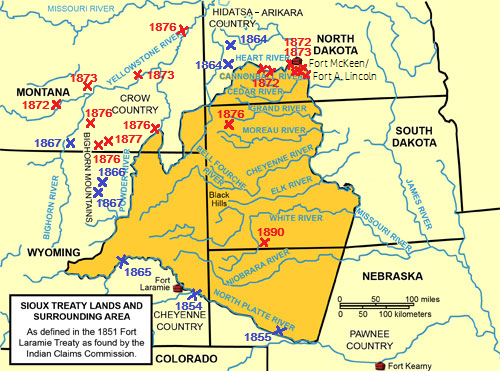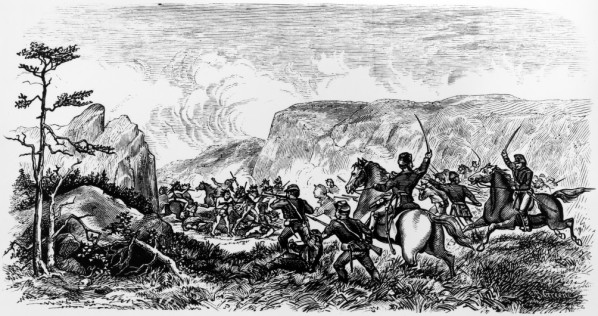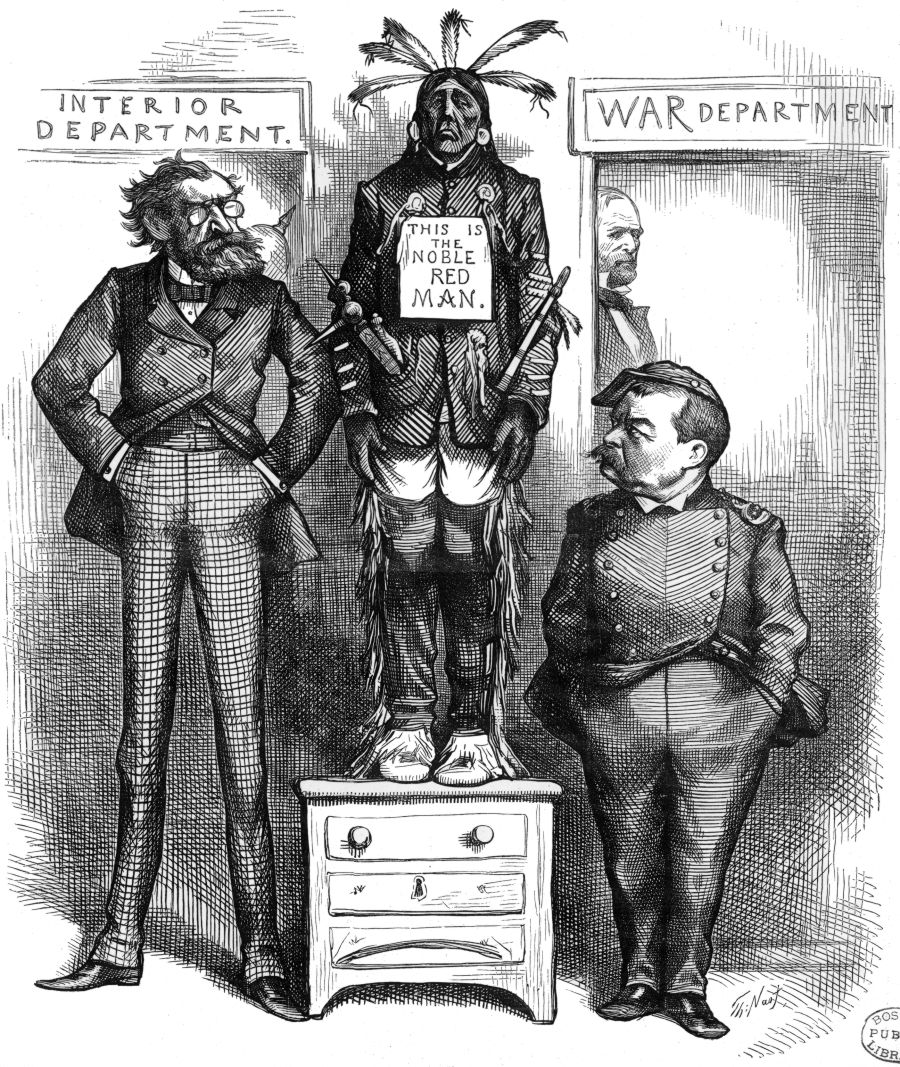Sioux Wars
From Warlike
Q3778746
conflicts between the USA and subgroups of the Sioux people from 1854–1890.
Wikimedia, Wikidata
1854 — 1891
American Indian Wars, Battle of Ash Hollow, Battle of Big Mound, Battle of Dead Buffalo Lake, Battle of Killdeer Mountain, Battle of Stony Lake, Battle of the Badlands, Battle of Whitestone Hill, Black Hills Expedition, Canada, Colorado War, Dakota War of 1862, Ghost Dance War, Grattan massacre, Great Sioux War of 1876, Powder River Expedition, Red Cloud's War, United States, war, Yellowstone Expedition of 1873, 
Location: 40.0, -100.0,
KML,
Maps































American Indian Wars – Battle of Ash Hollow – Battle of Big Mound – Battle of Dead Buffalo Lake – Battle of Killdeer Mountain – Battle of Stony Lake – Battle of the Badlands – Battle of Whitestone Hill – Colorado War – Dakota War of 1862 – Ghost Dance War – Grattan massacre – Great Sioux War of 1876 – Red Cloud's War – Red River War – Villasur expedition massacre –
1854-08-19T00:00:00Z
1854-08-19
1891-01-01T00:00:00Z
1891-01-01
1855-09-03T00:00:00Z
Battle of Ash Hollow 1855
1863-07-24T00:00:00Z
Battle of Big Mound 1863
1863-07-26T00:00:00Z
1864-07-28T00:00:00Z
1863-07-28T00:00:00Z
Battle of Stony Lake 1863
1863-09-03T00:00:00Z
1864-08-07T00:00:00Z
1874-07-02T00:00:00Z
1862-08-17T00:00:00Z
Dakota War of 1862 1862
1890-12-29T00:00:00Z
Ghost Dance War 1890
1854-08-19T00:00:00Z
Grattan massacre 1854
1876-01-01T00:00:00Z
1865-07-01T00:00:00Z
1866-01-01T00:00:00Z
Red Cloud's War 1866
1873-06-20T00:00:00Z
{"selectable":false,"width":"100%","zoomMin":100000000000}
 Abdul-Hamid II, the present Sultan of Turkey Montana Territory - the Sioux campaign - the Battle of Wolf Mountains, January 8th, between the command of General Mines and the confederate LCCN94501468
Abdul-Hamid II, the present Sultan of Turkey Montana Territory - the Sioux campaign - the Battle of Wolf Mountains, January 8th, between the command of General Mines and the confederate LCCN94501468 A map showing the Custer Battlefield at the Little Bighorn River (1876) in the Crow Reservation, Montana, established on May 7, 1868
A map showing the Custer Battlefield at the Little Bighorn River (1876) in the Crow Reservation, Montana, established on May 7, 1868 Dewey Beard a.k.a. Iron Hail, Miniconjou Lakota, participant at the battle of the Little Bighorn, survivor of the Wounded Knee Massacre
Dewey Beard a.k.a. Iron Hail, Miniconjou Lakota, participant at the battle of the Little Bighorn, survivor of the Wounded Knee Massacre Dewey Beard a.k.a. Iron Hail, Miniconjou Lakota, participant at the battle of the Little Bighorn, survivor of the Wounded Knee Massacre
Dewey Beard a.k.a. Iron Hail, Miniconjou Lakota, participant at the battle of the Little Bighorn, survivor of the Wounded Knee Massacre Dewey Beard a.k.a. Iron Hail, Miniconjou Lakota, participant at the battle of the Little Bighorn, survivor of the Wounded Knee Massacre
Dewey Beard a.k.a. Iron Hail, Miniconjou Lakota, participant at the battle of the Little Bighorn, survivor of the Wounded Knee Massacre Dewey Beard a.k.a. Iron Hail, Miniconjou Lakota, participant at the battle of the Little Bighorn, survivor of the Wounded Knee Massacre
Dewey Beard a.k.a. Iron Hail, Miniconjou Lakota, participant at the battle of the Little Bighorn, survivor of the Wounded Knee Massacre Father De Smets 1851 map of the native territories as put down in the Fort Laramie treaty (1851). The white X marks the Custer Battlefield at the Little Bighorn River (1876) in treaty defined territory of the Crow
Father De Smets 1851 map of the native territories as put down in the Fort Laramie treaty (1851). The white X marks the Custer Battlefield at the Little Bighorn River (1876) in treaty defined territory of the Crow Map of the country embraced in the recent campaign against the Sioux Indians of Dakota showing the position of troops from the beginning to surrender in January 1891
Map of the country embraced in the recent campaign against the Sioux Indians of Dakota showing the position of troops from the beginning to surrender in January 1891 Map of the country embraced in the recent campaign against the Sioux Indians of Dakota showing the position of troops from the beginning to surrender in January 1891
Map of the country embraced in the recent campaign against the Sioux Indians of Dakota showing the position of troops from the beginning to surrender in January 1891 The map shows the Custer Battlefield at the Little Bighorn River (1876) in the Crow Reservation in Montana and the Great Sioux Reservation with the Black Hills in South Dakota
The map shows the Custer Battlefield at the Little Bighorn River (1876) in the Crow Reservation in Montana and the Great Sioux Reservation with the Black Hills in South Dakota The map shows the land of the Lakotas according to the Fort Laramie treaty (1851) and many of the battlefields between them and the U.S. Army from 1854 to 1890
The map shows the land of the Lakotas according to the Fort Laramie treaty (1851) and many of the battlefields between them and the U.S. Army from 1854 to 1890 The map shows the land of the Lakotas according to the Fort Laramie treaty (1851) and the place and the year for many of the battles between them and the U.S. Army from 1854 to 1890 indicated
The map shows the land of the Lakotas according to the Fort Laramie treaty (1851) and the place and the year for many of the battles between them and the U.S. Army from 1854 to 1890 indicatedIndividual site searches
Google custom search of specialist sites
Google custom search of general sites


























